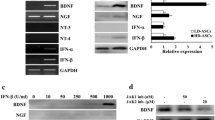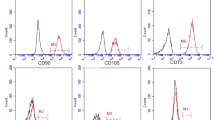Abstract
Human adipose stem cells (hADSCs) are proper cell sources for tissue regeneration. They mainly mediate their therapeutic effects through paracrine factors as exosomes. The exosomes contents are protein, lipid and RNA. Exosomes are effective in restoring the function of neurons and astrocytes in neurodegenerative diseases, and improve the therapeutic outcomes. We investigated the effect of hADSCs derived exosomes on survival and neural differentiation of PC12 cells in vitro. The isolated hADSCs, were characterized by flow cytometry. Exosomes were separated from hADSC-condition medium using Exo-spinTM kit and characterized by DLS and TEM. Then acridine orange staining was performed to confirm entrance of exosomes into PC12 cells. PC12 cells were treated with culture medium containing NGF and exosome. Cell viability was assessed by MTT assay, and neural differentiation by ICC technique and qRT-PCR. TEM and DLS data confirmed the isolation of exosomes according to their size (30–100 nm) and acridine orange staining indicated entrance of exosomes to target cells. MTT assay showed that cell viability was significantly increased in exosome treated group. ICC technique revealed that the expression of Map2 was superior in the exosome treated group. Based on qRT-PCR data, Map2 and β-tub III gene expression was increased in the exosome treated group. Significant expression of Gfap was seen in the NGF and NGF/EXO treated groups. Present study indicated that hADSCs derived exosomes might enhance cell viability and promote neuronal differentiation and expression of mature neural marker in PC12 cells.






Similar content being viewed by others
References
Blundell R, Shah M (2015) Neurodegenerative diseases and stem cell transplantation. J Stem Cell Res Ther 5(277):10.4172
Kim SU, De Vellis J (2009) Stem cell-based cell therapy in neurological diseases: a review. J Neurosci Res 87(10):2183–2200
Nawaz M, Fatima F, Vallabhaneni KC, Penfornis P, Valadi H, Ekström K et al (2016) Extracellular vesicles: evolving factors in stem cell biology. Stem Cells Int 2016:1–17. https://doi.org/10.1155/2016/1073140
Salehi H, Amirpour N, Niapour A, Razavi S (2016) An overview of neural differentiation potential of human adipose derived stem cells. Stem Cell Rev Rep 12(1):26–41
Krampera M, Pasini A, Pizzolo G, Cosmi L, Romagnani S, Annunziato F (2006) Regenerative and immunomodulatory potential of mesenchymal stem cells. Curr Opin Pharmacol 6(4):435–441
Lin SS, Zhu B, Guo ZK, Huang GZ, Wang Z, Chen J et al (2014) Bone marrow mesenchymal stem cell-derived microvesicles protect rat pheochromocytoma PC12 cells from glutamate-induced injury via a PI3K/Akt dependent pathway. Neurochem Res 39(5):922–931
Farinazzo A, Turano E, Marconi S, Bistaffa E, Bazzoli E, Bonetti B (2015) Murine adipose-derived mesenchymal stromal cell vesicles: in vitro clues for neuroprotective and neuroregenerative approaches. Cytotherapy 17(5):571–578
Amirpour N, Amirizade S, Hashemibeni B, Kazemi M, Hadian M, Salehi H (2019) Differentiation of eye field neuroectoderm from human adipose-derived stem cells by using small-molecules and hADSC-conditioned medium. Ann Anat 221:17–26
Madrigal M, Rao KS, Riordan NH (2014) A review of therapeutic effects of mesenchymal stem cell secretions and induction of secretory modification by different culture methods. J Transl Med 12(1):260
Marote A, Teixeira FG, Mendes-Pinheiro B, Salgado AJ (2016) MSCs-derived exosomes: cell-secreted nanovesicles with regenerative potential. Front Pharmacol 7:231
Shabbir A, Cox A, Rodriguez-Menocal L, Salgado M, Badiavas EV (2015) Mesenchymal stem cell exosomes induce proliferation and migration of normal and chronic wound fibroblasts, and enhance angiogenesis in vitro. Stem Cells Dev 24(14):1635–1647
Fatima F, Nawaz M (2015) Stem cell-derived exosomes: roles in stromal remodeling, tumor progression, and cancer immunotherapy. Chin J Cancer 34(3):46
Phinney DG, Pittenger MF (2017) Concise review: MSC-derived exosomes for cell-free therapy. Stem Cells 35(4):851–858
Liu WZ, Ma ZJ, Li JR, Kang XW (2021) Mesenchymal stem cell-derived exosomes: therapeutic opportunities and challenges for spinal cord injury. Stem Cell Res Ther 12(1):102
Katerji M, Barada K, Jomaa M, Kobeissy F, Makkawi A-K, Abou-Kheir W et al (2017) Chemosensitivity of U251 cells to the co-treatment of D-penicillamine and copper: possible implications on Wilson disease patients. Front Mol Neurosci 10:10
Pera M, Camps P, Muñoz-Torrero D, Perez B, Badia A, Guillen MVC (2013) Undifferentiated and differentiated PC12 cells protected by huprines against injury induced by hydrogen peroxide. PLoS ONE 8(9):e74344
Lobb RJ, Becker M, Wen Wen S, Wong CS, Wiegmans AP, Leimgruber A et al (2015) Optimized exosome isolation protocol for cell culture supernatant and human plasma. J Extracell Vesicles 4(1):27031
Yang L, Wu X-H, Wang D, Luo C-L, Chen L-X (2013) Bladder cancer cell-derived exosomes inhibit tumor cell apoptosis and induce cell proliferation in vitro. Mol Med Rep 8(4):1272–1278
Baranyai T, Herczeg K, Onódi Z, Voszka I, Módos K, Marton N et al (2015) Isolation of exosomes from blood plasma: qualitative and quantitative comparison of ultracentrifugation and size exclusion chromatography methods. PLoS ONE 10(12):e0145686
Ebrahim N, Ahmed I, Hussien N, Dessouky A, Farid A, Elshazly A et al (2018) Mesenchymal stem cell-derived exosomes ameliorated diabetic nephropathy by autophagy induction through the mTOR signaling pathway. Cells 7(12):226
Takeda YS, Xu Q (2015) Neuronal differentiation of human mesenchymal stem cells using exosomes derived from differentiating neuronal cells. PLoS ONE 10(8):e0135111
Waldenström A, Gennebäck N, Hellman U, Ronquist G (2012) Cardiomyocyte microvesicles contain DNA/RNA and convey biological messages to target cells. PLoS ONE 7(4):e34653
Lee M, Ban JJ, Kim KY, Jeon GS, Im W, Sung JJ et al (2016) Adipose-derived stem cell exosomes alleviate pathology of amyotrophic lateral sclerosis in vitro. Biochem Biophys Res Commun 479(3):434–439
Amirpour N, Razavi S, Esfandiari E, Hashemibeni B, Kazemi M, Salehi H (2017) Hanging drop culture enhances differentiation of human adipose-derived stem cells into anterior neuroectodermal cells using small molecules. Int J Dev Neurosci 59:21–30
Shen T, Zheng QQ, Shen J, Li QS, Song XH, Luo HB et al (2018) Effects of adipose-derived mesenchymal stem cell exosomes on corneal stromal fibroblast viability and extracellular matrix synthesis. Chin Med J 131(6):704
Hu L, Wang J, Zhou X, Xiong Z, Zhao J, Yu R et al (2016) Exosomes derived from human adipose mensenchymal stem cells accelerates cutaneous wound healing via optimizing the characteristics of fibroblasts. Sci Rep 6:32993
Van der Pol E, Böing AN, Harrison P, Sturk A, Nieuwland R (2012) Classification, functions, and clinical relevance of extracellular vesicles. Pharmacol Rev 64(3):676–705
Jadli AS, Ballasy N, Edalat P, Patel VB (2020) Inside (sight) of tiny communicator: exosome biogenesis, secretion, and uptake. Mol Cell Biochem 467(1):77–94
Gao M, Gao W, Papadimitriou J, Zhang C, Gao J, Zheng M (2018) Exosomes—the enigmatic regulators of bone homeostasis. Bone Res 6(1):1–13
Choi EW, Seo MK, Woo EY, Kim SH, Park EJ, Kim S (2018) Exosomes from human adipose-derived stem cells promote proliferation and migration of skin fibroblasts. Exp Dermatol 27(10):1170–1172
Zhang Y, Chopp M, Meng Y, Katakowski M, Xin H, Mahmood A et al (2015) Effect of exosomes derived from multipluripotent mesenchymal stromal cells on functional recovery and neurovascular plasticity in rats after traumatic brain injury. J Neurosurg 122(4):856–867
Xin H, Li Y, Cui Y, Yang JJ, Zhang ZG, Chopp M (2013) Systemic administration of exosomes released from mesenchymal stromal cells promote functional recovery and neurovascular plasticity after stroke in rats. J Cereb Blood Flow Metab 33(11):1711–1715
Xin H, Katakowski M, Wang F, Qian JY, Liu XS, Ali MM et al (2017) MicroRNA-17–92 cluster in exosomes enhance neuroplasticity and functional recovery after stroke in rats. Stroke 48(3):747–753
Bucan V, Vaslaitis D, Peck CT, Strauß S, Vogt PM, Radtke C (2019) Effect of exosomes from rat adipose-derived mesenchymal stem cells on neurite outgrowth and sciatic nerve regeneration after crush injury. Mol Neurobiol 56(3):1812–1824
Xin H, Li Y, Buller B, Katakowski M, Zhang Y, Wang X et al (2012) Exosome-mediated transfer of miR-133b from multipotent mesenchymal stromal cells to neural cells contributes to neurite outgrowth. Stem Cells 30(7):1556–1564
Korzhevskii D, Karpenko M, Kirik O (2012) Microtubule-associated proteins as indicators of differentiation and the functional state of nerve cells. Neurosci Behav Physiol 42(3):215–222
Garcia ADR, Doan NB, Imura T, Bush TG, Sofroniew MV (2004) GFAP-expressing progenitors are the principal source of constitutive neurogenesis in adult mouse forebrain. Nat Neurosci 7(11):1233
Wang Y, Lai X, Wu D, Liu B, Wang N, Rong L (2021) Umbilical mesenchymal stem cell-derived exosomes facilitate spinal cord functional recovery through the miR-199a-3p/145-5p-mediated NGF/TrkA signaling pathway in rats. Stem Cell Res Ther 12(1):117
Titapiwatanakun B, Murphy AS (2009) Post-transcriptional regulation of auxin transport proteins: cellular trafficking, protein phosphorylation, protein maturation, ubiquitination, and membrane composition. J Exp Bot 60(4):1093–1107
Acknowledgements
Not applicable
Funding
This study extracted from a M.Sc project and financially supported by Isfahan University of Medical Sciences (Project No. 396571).
Author information
Authors and Affiliations
Contributions
All authors contributed to the study conception and design. Material preparation, data collection and analysis were performed by Samira Shariati Najafabadi, Noushin Amirpour and Hossein Salehi. The first draft of the manuscript was written by Samira Shariati Najafabadi and all authors commented on previous versions of the manuscript. All authors read and approved the final manuscript.
Corresponding author
Ethics declarations
Conflict of interest
The authors declare that they have no known competing financial interests or personal relationships that could have appeared to influence the work reported in this paper.
Informed consent
The adipose tissue samples were legally achieved by collecting a written consent approved by Care Committee of Isfahan University of Medical Sciences (IR.MUI.REC.1396.3.571).
Additional information
Publisher's Note
Springer Nature remains neutral with regard to jurisdictional claims in published maps and institutional affiliations.
Rights and permissions
About this article
Cite this article
Shariati Najafabadi, S., Amirpour, N., Amini, S. et al. Human adipose derived stem cell exosomes enhance the neural differentiation of PC12 cells. Mol Biol Rep 48, 5033–5043 (2021). https://doi.org/10.1007/s11033-021-06497-5
Received:
Accepted:
Published:
Issue Date:
DOI: https://doi.org/10.1007/s11033-021-06497-5




